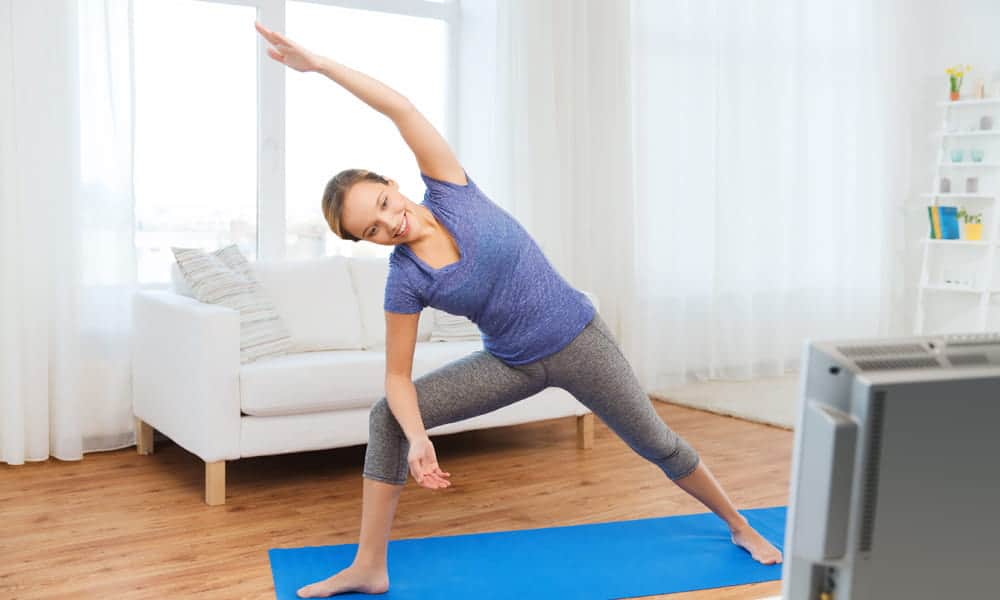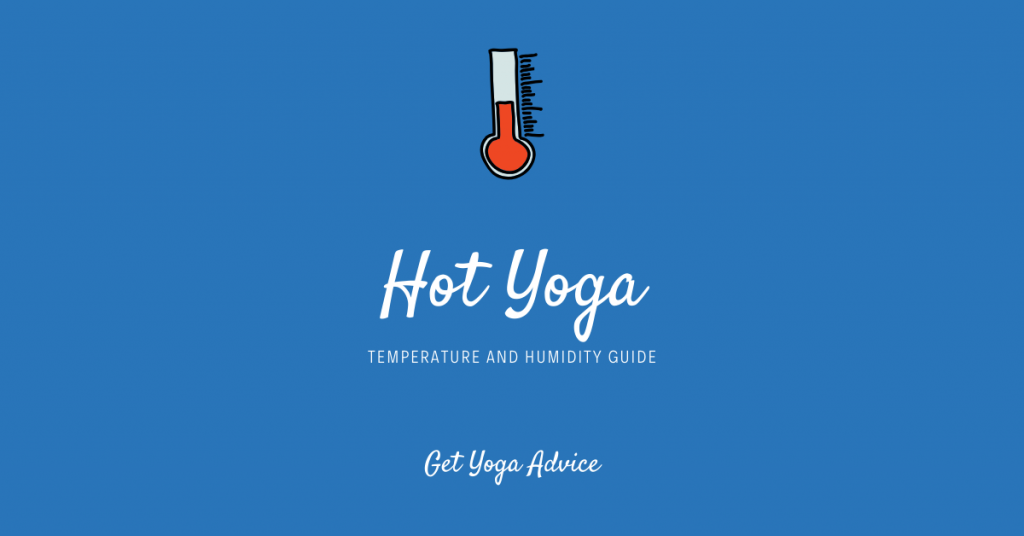Discover the hot yoga temperature and humidity guide in this article.
Have you ever wondered how hot yoga works when it comes to temperature and humidity? As in, is there a method to the madness or does the hot yoga instructor simply hike up the temperature until it’s hot enough to encourage some serious sweat?
While these are valid questions, you should know that there is a reason for the specific temperatures and levels of humidity that come along with hot yoga. And, in fact, the hot yoga temperature and humidity work together to increase the effectiveness of your workout by allowing you to sink deeper into positions and decrease the risk of injury.
We put together this hot yoga temperature and humidity guide so you can understand how it all works.
Contents
- 1 Benefits of Hot Yoga
- 2 Is Hot Yoga Be Dangerous for Your Health?
- 3 What is the Relationship Between Temperature and Humidity?
- 4 The Different Types of Hot Yoga and Their Ideal Temperatures
- 5 Baptiste Power Vinyasa
- 6 How to Stay Safe During Hot Yoga
- 7 The Final Word About Hot Yoga Temperature and Humidity
Benefits of Hot Yoga
Let’s have a quick look into some of the benefits of hot yoga. The sometimes sweltering temperatures of hot yoga are set this way for a reason – to optimize your workout and maximize potential health benefits. Here are some benefits of hot yoga that you may not know:
- Increases flexibility
- Improves circulation
- Nourishes the skin
- Increases metabolism
- Provides a cardiovascular boost
- Reduces stress and improves mood
- Helps promote mindfulness
- Increases oxygen levels
Is Hot Yoga Be Dangerous for Your Health?
As many benefits as there are to hot yoga, there has also been a lot of speculation on whether or not hot yoga is dangerous for your health.
Most hot yoga studios do fall into the danger zone when it comes to their high heat index. It’s considered dangerous to have prolonged exposure to a heat index that meets or exceeds 103°F and hot yoga studios usually surpass this. Prolonged exposure to and participating in physical activity in this sort of heat can lead to dangerous heat disorders and unhealthy air quality.
Having said this, hot yoga is safe for most people as long as they keep hydrated before, during and after a hot yoga session. You should not do hot yoga if you have high blood pressure or a heart condition or if you are pregnant.
All in all, hot yoga has a variety of benefits and is considered generally safe, though you should consult your healthcare practitioner if you suffer from a health condition that you are unsure whether or not it could be affected.
What is the Relationship Between Temperature and Humidity?
There are multiple reasons why temperature and humidity matter what it comes to hot yoga – and it starts with mimicking the environment in which yoga began. For example, when it comes to Bikram yoga in particular, the temperature is usually set to 105°F and 40% humidity. This is meant to replicate the climate of India as exactly as possible.
This climate cannot be replicated without also changing the humidity. When the temperature rises, the amount of moisture in the air usually rises with it. Therefore, the temperature ends up feeling warmer than it actually is. This is known as the heat index. It’s similar to a wind chill index, where the wind makes the temperature feel colder than it actually is.
When it comes to hot yoga, the temperature and humidity work together to increase the benefits of the workout.
The Different Types of Hot Yoga and Their Ideal Temperatures
There are at least five different types of hot yoga classes and not all of them fall under the same heat index. Hot yoga temperature and humidity vary depending on the type of yoga you’re doing. Let’s take a look at the ideal temperatures for different types of hot yoga so you can make a better decision on which type may suit you best:
Bikram Yoga

This is the most popular type of hot yoga and the most well-known. Bikram yoga is fairly rigid in both the number of poses it covers as well as the temperature and humidity that the studio should be. Classes usually last for about 90 minutes and contain a series of 26 specific poses.
Bikram yoga has the highest heat index of any type of yoga and is meant to most closely mimic the climate of India. The temperature is typically set to 105°F with a 40% humidity level. Some studios even crank up the humidity to 60%, causing the temperature to be as high as 149°F (a whopping 65°C).
Evolation Yoga
Evolation yoga is a modified version of the Bikram structure and concentrates more on the journey within the self by implementing simple yoga techniques rather than following a structured number of poses. While Evolation yoga is usually set to the same 105°F as Bikram yoga, some courses offer temperatures as low as 75°F.
CorePower Yoga
CorePower Yoga classes are multi-disciplinary and vigorous and focus on teaching students how to connect with their bodies and access their spiritual side. A CorePower yoga session is usually set anywhere from 93 to 98°F.
Moksha Yoga/Modo Yoga

This type of yoga is known for being “green”, right down to the color of their studios. But the commitment to being green also involves keeping their Moksha yoga studios environmentally friendly. They use sustainable building materials and natural cleansers. Similar to Bikram yoga, Moksha yoga’s standard workout runs for 90 minutes but it follows a sequence of 40 poses rather than 26. The studio is also set to 103°F making Moksha studios slightly cooler than Bikram.
Baptiste Power Vinyasa
This last type of hot yoga focuses on adapting to the needs of each individual and is heavy with modifications and adaptations to any level of physical ability. It focuses on tapping into one’s inner spiritual core, meditation, and flowing postures. These classes run from 75 to 90 minutes and the temperature is set from 90 to 95°F. While humidity is also added, some yoga studios actually pump in fresh air as well.
How to Stay Safe During Hot Yoga
As stated, hot yoga is generally safe as long as you do not have any preexisting health conditions. That said, a hot yoga session can quickly become unsafe for anyone if you are not prepared and have not taken the necessary precautions.
Making sure you stay hydrated is by far the most important way to stay safe during hot yoga. While it’s most important that you come to class hydrated, you should also stay hydrated as best you can during your hot yoga session. Take a few sips of water for every new asana.
If your body is telling you that something’s up, make sure you listen rather than powering through. If you begin to feel light-headed, nauseous, or generally unwell, make sure you take it easy and amp up your water intake. If you find that you’re not getting properly hydrated from water alone, consider a drink with electrolytes. You can find electrolytes in sports drinks and added into water or naturally in coconut water.
If preexisting injuries are an issue for you and you still decide to participate in hot yoga, make sure you’re not exacerbating the situation. Do not attempt any poses that cause pain and let the instructor know that you require modifications. Many of the types of yoga mentioned above focus on providing modifications to those who need it. If you power through and worsen your injury, you take away from the benefits of yoga that you set out to find in the first place.
The Final Word About Hot Yoga Temperature and Humidity
Now that you know what’s what when it comes to its temperature and humidity, we hope that you consider trying a type of hot yoga that is right for you. Not every type of hot yoga is swelteringly hot and you can participate in a relaxing session without experiencing what it’s like to work out on a hot day in India.



